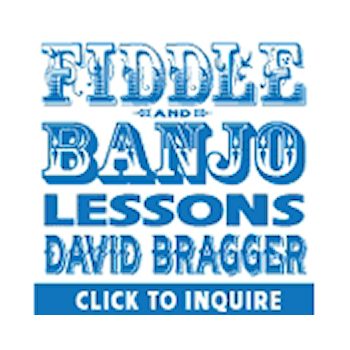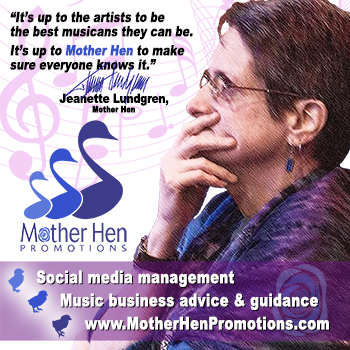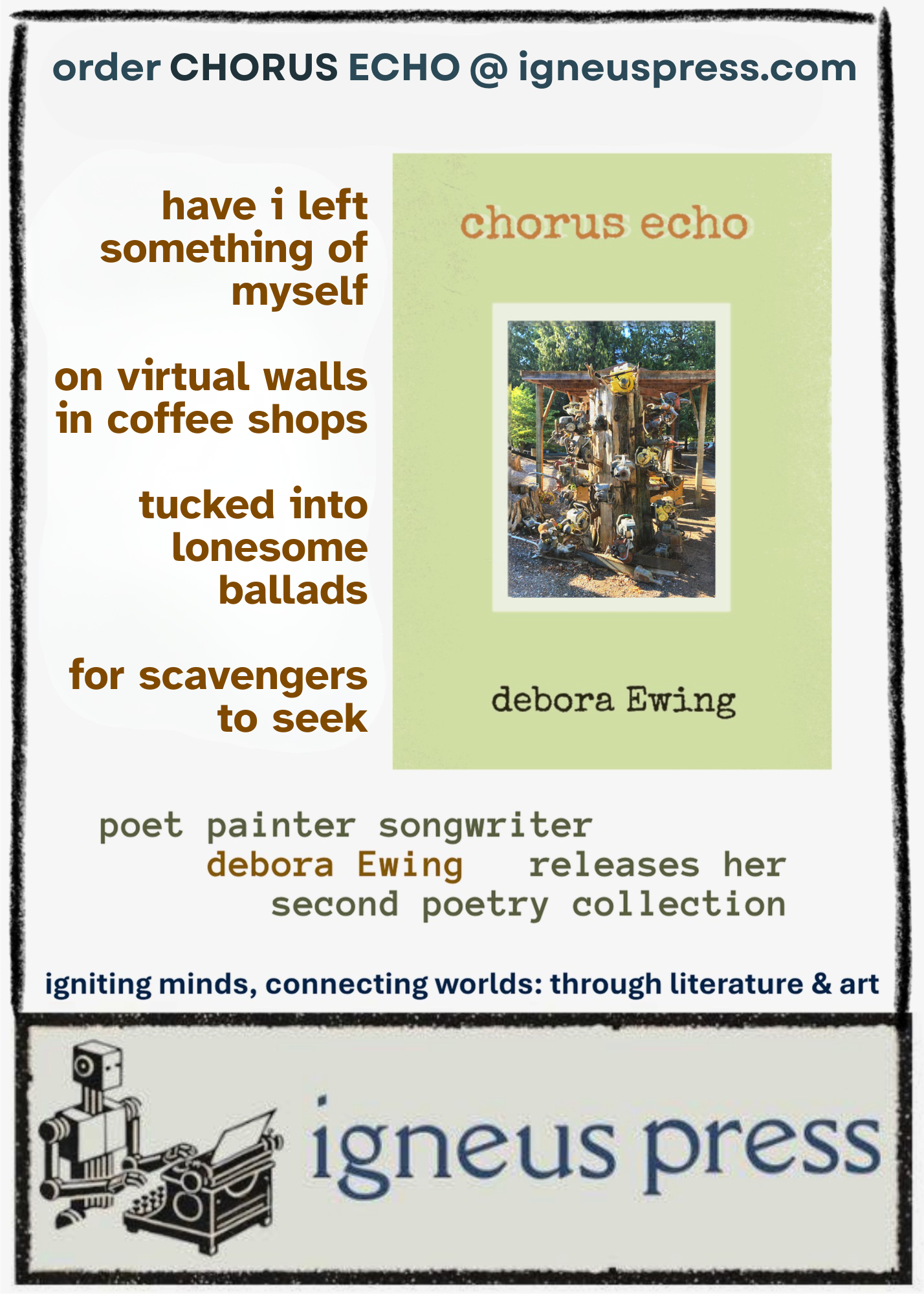Donna Lynn Caskey – Daughter of the Tidewater
The Banjo Gal on Creativity, Service, Through-lines and Finding Your Own
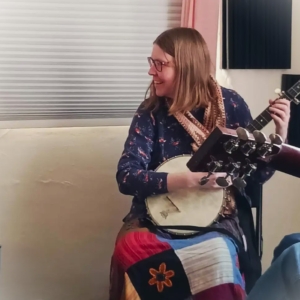
Donna Lynn Caskey, FolkWorks party 3.31.25, photo by deb Ewing
I met Donna Lynn Caskey at the FolkWorks party in March of 2025 – a reminiscence of grand shindigs that used to happen in the Shapiros’ Los Angeles home back in the day. It was a family reunion of sorts; even Donna Lynn thought so: “I thought it was cool. I had a good time… I think it helped that me and a few people found a good room to Song Circle in.” Songcircling as a verb – this is one of many creative perspectives Donna Lynn has added to my lexicon.
When I reviewed Tiny Victories, Donna Lynn Caskey’s latest album, I found that she, too, is a visual artist. The cover image of her CD is actually a mixed-media self-portrait created with bits of tissue paper and paint. DLC is a multimedia artist.
Folks, that’s why I’m here. Let’s get down to it.
me: I don’t usually ask this question, but I want to know about your roots. What are your roots?
dlc: Well, I grew up in Virginia Beach, the Tidewater area of Virginia. I’m a little frustrated, because it was even printed recently that I’m from Appalachia. I guess people assume like,”Oh, you’re from Virginia and play the banjo. You must be from Appalachia.”
I’m like, “I’m not a Beverly Hillbilly,” as I have spent about half my life now in Southern California. I did go to college in Appalachia, but that was when I was ages 18 through 21.
me: I’m asking because the roots of banjo in America are thought to be Appalachian.
dlc: Well, there’s a lot of mythology around the banjo, but from what I understand the banjo was first documented in places like the Caribbean, the Tidewater, the flatlands on the east coast, Louisiana – New Orleans, Suriname. Yes, the banjo eventually got to Appalachia, and obviously the banjo got all over the place including Irish music. There’s a beautiful book I love and recommend: Well of Souls by Kristina Gaddy that talks about some of the lesser-known history of the banjo and where it was first documented.
me: In my conversation with Hannah Mayree, she questioned the difference between the California banjo community vs. the East Coast, which seems closer to the source. What are the differences that you perceive?
dlc: Well, I’m no expert. I kind of did my own thing. I’m familiar with old time music – it’s in my family to a certain extent, or what got called old time music. Of course, all these genres got made up: some of the same songs got labeled blues or hillbilly depending on the skin color of the person playing. I mean, it was a marketing thing.
me: So which music did your family introduce you to?
dlc: Well, all kinds. I have nine older siblings; my parents were technically old enough to be my grandparents. I got exposed to all kinds of music. But yeah, my Granny – my maternal Granny – she and her sister would sing unaccompanied music at churches around Henrico County of Virginia when they were young girls. I remember her saying her dad played for dances. And then I remember one time going with a friend to Virginia when my Granny was still alive and playing some music. Granny was like, “Oh, is that the Johnson Boys?” She knew all of the verses to “The Wreck of the Old 97” and talked about singing that on the way to school when she was little. She was born in 1909.
(editor’s note: The wreck of the Fast Mail happened in 1903. The lyrics were originally attributed to Charles Weston Noell and Fred Jackson Lewey, whose cousin Albion Clapp was one of the two firemen killed.)
And then my sisters: I have a set of sisters who are identical twins, 13 years older than me. One of ’em plays viola; one plays violin and is a music therapist. There was just so much music, which I’m grateful for. Records of popular music, old music, music on the radio, music I’d check out from the library, music that my sisters played. I was grateful to be exposed to a lot. So that all was in the mix.
me: What really grabbed your soul, though?
dlc: I loved all kinds of music, anything that moved me emotionally in any way, but I always appreciated songwriting, and I was definitely a writer. I’d write poems and stories growing up. When I was in college, actually in Appalachia – Roanoke, Virginia – I really started getting into bluegrass and old time music. I was a member of the Fiddle and Banjo Club there; I’d go and drag my friends along, or would go listen to these bluegrass and old-time jams at the flea market. So that’s kind of when the banjo really captured me.
Then I went to a concert of Mike Seeger’s, and of course he was there playing all these instruments by ear. I had trouble reading piano music notation when I took lessons as a kid. So I’d kind of got this mistaken notion in my head: Okay, as much as I love music, I’m bad at it in a certain way. Even though before that, I loved to just make stuff up on the piano or sing.
But Mike Seeger talking about Folk music being of and for folks, for anybody and everybody, and playing all of these instruments by ear – when by ear always worked for me – was sort of the light bulb. Music throughout time and history was primarily an oral tradition. It’s only been relatively recently that there’ve been different types of music notation.
So just that reminder- that there’s more than one way- was a different on-ramp to playing music for me. I got myself a banjo for college graduation. I played old time music when I got into playing. But three months into playing banjo in earnest, I was making up songs. I would go to jams and stuff for a while, but there’s always that streak in me where I start making up stuff myself.
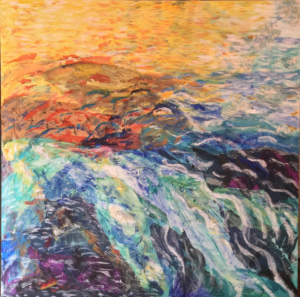
Waves, Depths, Reflections, 48×48, Donna Lynn Caskey
me: I understand. I’ve always been one of those making up stuff people, which sometimes was encouraged and sometimes adamantly discouraged. So how did you end up in California and when?
dlc: Well, by train.
me: That’s pretty classical.
dlc: Right? I did one semester of graduate school out here when I first moved out, and I thought that’s what I was moving out here to do. I call it the bait that got me here. But it ended up not being the be-all-end-all, which is actually a good thing, because it took me several years to pay off that one semester of graduate school. Good thing I didn’t do anymore. That would’ve been unmanageable. My second day of class was 9/11, however, so that school was a wonderful place to be that day, all considered.
me: What was your major?
dlc: Well, that’s the thing. I went to Pacifica, and I was in this program called Mythological Studies, which was world religions and depth psychology and mythology, which is great. I love all that stuff, but okay, I already have a degree in art, and here I am on another mythological topic that might result in a rather mythological way of supporting myself.
me: Right, right, but…
dlc: I’d started playing banjo just a few months before I moved, but then when I got here, even the first day I was in town, I met a fiddler at the farmer’s market, and he told me where this old time jam was in the park. So I fell into this local old time music community. Who has time for grad school and debt to read books I like to read anyway? But I didn’t exactly have a big ambition or clear plan, if that makes sense.
me: So you were an art major, and that brings me around to the other branch of the conversation. What I’m trying to do is answer this: A lot of people advised me to just pick one thing and specialize in it? I can’t.
dlc: Yeah. That’s not who you are. My parents, bless their hearts, grew up in the depression, abject poverty. There wasn’t even running water at my mom’s house until after she moved out. And my dad made the comment when he met my mother in the 1950s and saw the house she grew up in he thought it was going to fall down. My Granny continued to live there another 40 plus years.
My dad was a clever writer, there was a lot of creativity and music in my family, and an appreciation of music by my mother in particular, but then also that sense of, “well, that’s nice you won that writing award. That’s nice you won that art award, but how are you going to support yourself?!”
me: I think, especially nowadays, we should be raising children to understand that they are going to need two careers, two sources of income, and possibly three. So one of those should be something you’re passionate about. And it’s all connected – all disciplines – from a creative standpoint.
dlc: So here’s a little bit of my path, just for what it’s worth, and this is not a bragging thing, this is something that just kind of came naturally to me. Visual art came pretty naturally to me. And in school, I won a lot of awards for visual art, and I won scholarships for visual art to go to college. But then when I was actually looking at colleges, I was looking at potentially going to art schools, but I’m the type of person I like to learn about a lot of things. Creativity and connection and heart. Those are big values in my life, but I like learning about all kinds of things. To me, I see the connections, I see the through-lines, also service. That’s huge.
And to me, I can also see arts as service. It probably saved my life, making things and sharing that with people, or saying, “Hey, you can make stuff, too.” It doesn’t have to be good. It doesn’t have to be on the wall of a gallery.

In the Solution, 24×30, Donna Lynn Caskey
As humans, it seems inherent to create: paintings on cave walls, petroglyphs, song and dance as an intrinsic part of life, spirituality, community across cultures and centuries. It seems good for us as humans to create at whatever level, for any audience even if only for ourselves or a handful of friends. By making music, singing, drawing, baking, dancing, painting, woodwork, whatever, we lift our own spirits and that has a ripple effect out into the world, flavors our interactions with others. Creating as part of our own total health and well-being, which can make us more of a joy to be around. That’s a service!
For me, creating is also very connected to spirituality and intuition. No coincidence that “Creator” a word for the divine and that inspiration, spirit, respiration all related words. Art as a form of communication and connection between others, with life itself. Art bringing people together, a shared experience, can foster community, can rally folks in righteous protest or around a noble cause.
A service when voices join together in song, when someone is moved to tears or moved to dance. A service when a song, a film, a poem, a book, a photograph, a painting, a recipe, etc. etc. helps another feel less alone in their humanity, helps them feel seen and understood, inspires them, encourages them – imbues them with heart and courage, provokes thought, evokes a memory, creates a new memory. Art can be of service because it can help us better see and understand ourselves and others, art can foster empathy, compassion, self-compassion.
Art can entertain, distract, relieve, amuse, comfort, disturb – can be cathartic – can be mood-altering and set a mood, a time and place for the full range of experience and emotion. A service because each medium, modality, creator can express what cannot be expressed via other means. Sometimes art is the only safe outlet of expression. Creating and experiencing art can be life-saving.
It doesn’t have to be on a stage. It’s human to be creative, your version of putting something on the cave wall.
me: I like that. Art as service is a really important concept. Thank you. Because that was the other thing I heard growing up: “Okay, but what’s it good for? What can you use it for?” And so I got this weird twist, which actually has helped me, where everything has to be functional, but it can be functional and weird. But service is a function.
dlc: Or it’s so meditative to make things. So it’s like, okay, it helps me be a calmer, more centered, healthy person going out into my life. Great. What’s good for my mental health is good for anybody I come into contact with. There’s that, but also that thread of service. So here I am. I chose to go to a liberal arts college rather than art school. Again, I like to learn about a lot of things. And then, okay, yes, I won art awards, but was I particularly ambitious?
There was this trajectory like, oh, you go to New York City and you try to get in a gallery. I don’t know that I want to do stuff. I like to make things, and it’s nice if it touches people’s hearts in some way, bonus.
In terms of some ambition of some gallery, big city dream, that was not me. So I did liberal arts college, majored in art. So roll around senior year, a lot of my friends are doing internships. There were options like do an internship at a gallery downtown or do an internship at a museum. And I’m like, well, “when in doubt, help people” was my thing. I ended up doing a sociology internship at a drug and alcohol rehab home. I’ve worked for more than twenty years in social services, mostly as a social worker, now helping manage a social work program.
And that is how I have, in some way, funded my art and music habits, but then also have a job in a way that’s meaningful to me and of service. And there’s some common ground there, but that wasn’t necessarily a plotted thing. Just following the next little breadcrumb, stepping stone.
me: Yes. That all makes sense to me, and I’m still doing it.
dlc: “Welcome to life!”
me: Looking for breadcrumbs and waiting to see. Honestly, I’ve stopped plotting because I’m not good at that, and apparently I miscalculate really spectacularly. If it looks interesting, then I know that I’ll be dedicated to it, and like you said, and put heart into it. And that seems to be a better gauge of success.
So you had some, we could call it formal training in art, but that wasn’t your motivation. And music seems to be less formally trained.
dlc: Music was always part of my life. It was in my environment. I did take some piano lessons when I was a kid, but like I said that kind of ruined it for me for a minute because I wasn’t instantly good at reading the dots on the page; therefore, I must be bad at it. Or okay, I’m seven years old, and the 5-year-old who has the lesson before me is more advanced in the book. Oh! I should have started as a fetus.
As an adult looking back, I could reason and see that wasn’t true. But as a kid, I came to these conclusions: Oh, I must be bad at it. Oh, I started too late. Oh, I love music, but I’m bad at it. Also, I love to sing, but then at a certain point, kids would tease me for singing, so then I got quiet.
me: My mom would joke that she can’t sing, so I can’t either. So I just never approached it as if I could possibly carry a tune. Sometimes I can. But it sounds like we had similar social networks that leaned on negativity.
dlc: And that’s a human thing. Part of it’s that focusing on negativity helped us survive to a point, but that at another point, it backfires. Right? Having to get through the whole obstacle course of my own conditioning… It was very scary for me as an adult to start singing in public after I got quiet about it and just would do it if nobody was around or in a choir with 40 other people. Or it’s like, I’ve got asthma. But then to be brave through the fear and do it, or the inclusivity and accessibility of folk music. I am a folk singer. I can mostly carry a tune, but pitch, technique, breath support varies with what’s going on for me health-wise and nerve-wise sometimes.
me: So what do you see as comparison and contrast between visual art and music from a creative standpoint?

Finishing What I Started, 20×20, Donna Lynn Caskey
dlc: I’m madly in love with the creative process. In my experience, it doesn’t really matter the medium. I do a lot of mixed media artwork where it’ll be sort of tissue paper and paint and some found stuff, and I’ll stick it all together.
me: The album cover!
dlc: But then also I would say my songwriting process is similar. Okay. I’ve got a bit of melody I hummed into a voice memo, and I’ve got this theme, and I’ve got these words, and I have this memory, and I have this thing from a book and I’ll piece ’em together and see what kind of fits.
me: Have you ever had a visual art and a music piece come from the same inspiration?
dlc: So a visual art practice that I enjoy and that’s almost a rebellion against my formal art training: I love to rip up old magazines… basically recycling other people’s recycling or at the doctor’s office, “Do you need these old magazines? I’ll take them.” Ripping ’em up like a five-year-old: tape, lo-fi collage, very basic elementary school-like. But it’s like, I love doing that, because in a way, it’s no pressure. I’m not trying to make a masterpiece. It’s almost like a visual journaling thing.
me: I like the rebellion label.
dlc: Yeah. I mean, I enjoy that. And also, I enjoy doing something on a piece of canvas. A lot of the artwork in my home is artwork I made for the point of “I want something on that wall that I can live with, or that has meaning to me.” That’s kind of more –
me: That’s service art, too.
dlc: Exactly. But then that’s, I don’t know, more refined materials, like actual art supplies and paint and canvas versus scrap paper. The scrap paper and tape thing is fun. But there are times I’ve got to be careful to not get precious about songwriting, kind of keep it light and collage-like, that sort of rebellious, we’re just taping things together and see what goes. So doing that with actual paper can help me get more in that mode for a song also sometimes.
me: Yeah, that makes sense.
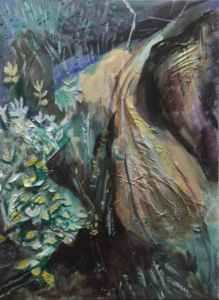
Chapparal, 18×24, Donna Lynn Caskey
dlc: A song called “Break Free” on my previous album, The Love Still Shows, there was an image in one of those modest tape-it-rip-it paper collages that helped inform a line on a song where I was stuck. I call it creative cross-pollination.
me: Cross-pollination – I use that word a lot.
dlc: To mix up the mediums or just to not get so stale and in a rut in one [medium], mix it up with doing something else a little bit.
me: So all of that is more fluid and less intentional, yeah? It sounds like you’re trying to keep it – how’d you say it – you try to not be precious.
dlc: …because there is an intention, but remembering music is something we play. I’ve dipped in and out of it, but for several years at the beginning of the pandemic, I was part of this online song club. We would get an optional prompt every week, but the idea was write a fast draft in an hour – voice memo and upload what you’ve got after an hour. So when you’re working that fast, you’re working faster than the inner critic and the editor, which it’s a damn good thing.
me: I’m laughing because that’s how I always work. I’m always done before everybody else and just sitting there and… Yeah, thing.
dlc: There’s something to being playful and fast because that way you don’t start picking at it before you’ve even got a draft- for me, it’s the doubt creeping in “is that too silly?” or “is that too corny?” or “is that embarrassing?” It gets past the editor, and it can be raw, and granted you can edit it and refine it. Several of the songs on my latest album (and my next album) started with these fast drafts. It just was a matter of actually learning how to play it or refining it here and there after that. But I would say the heart of the thing can come through pretty quickly.
me: “What Even if I Will” is my favorite, I think. That’s the one I replay the most and part of what I like about it is the raw feel of it. Now I can use some of the language that you’ve been using in describing art: It feels patched together and not cleaned up. And I could see where somebody might be tempted to try and make those lines into a complete proper sentence with the verb and the noun in the right place and stuff. I’m so glad you didn’t; glad you left it. I feel like there’s even an ancient voice coming through. My religious beliefs are sort of nebulous, but I do think – to use somebody else’s term – we are a link in the chain of something else, and sometimes those other voices can find the window, throw it on your desk and say, “Here, do this.”
dlc: I’ve got goosebumps! So that was a song that came out of the prompt “elder” in our online song club in 2020, early days of the pandemic. I’ve said the audience finishes the song, what the listener brings to it when they hear it finishes the song. So fascinating that you picked up on this ancient voice. If I recall what was on my heart when I wrote it, it was “what would an ancestor say? What would myself as a 90-year-old be telling my anxious self in this moment?” Higher powers, whatever that is for me or anybody, or even the wise part of ourselves talking to our anxious parts, however people interpret that. You got it.
me: Oh, that’s so cool~! I know absolutely nothing about music. I don’t play an instrument. What started out as a financial decision when I was a kid is now just pure stubbornness. I find value in what I don’t know; it makes me make decisions that nobody else would because they were trained better. And sometimes they’re terrible decisions, but sometimes they work.
dlc: The limitations can inform. In a way, too, I’m not a super paper-trained musician, and in some ways it does serve me –
me: I like that term: paper-trained musician.
dlc: You know what I mean, but –
me: I know exactly what you mean!
dlc: -but also there can be creativity in the limit, too. I am sure in some way it served me; in another way, it possibly hindered me. I also remember being in college photography class, and the professor giving us these plastic toy cameras. We could make amazing images, but part of it was the limitations of this device where you can’t change the aperture.
For me, not knowing music in a paper theory way, but in a heart gut way. But also music’s retained some of the mystery that way. I know this musician friend of mine, who went through extensive jazz training, said it was annoying at times. Just in the grocery store, part of their brain is analyzing what the intervals are in the Muzak – they wished they could turn that off sometimes. Whereas for me, it’s still just magic and mystery to be able to make music at all.
me: What I’m hearing is that our training – and when I say training in this case, I mean from kindergarten on up, we always have little art projects where we’re learning how to do things – is where we learn how to work within limitations. And so that training, I am hearing you say informs your music.
dlc: Kind of. Yeah. Or that there can be freedom in limitation because you have to get creative, but you can still make something even with the limit. Whereas if it’s all wide open and you have all these tools and skills and knowledge, it can almost be overwhelming. I mean, something can be simultaneously a strength and a weakness. I know sometimes in my mind, I feel like I’ve put music on a pedestal, or the mystery of it. Whereas I could actually learn more about theory and it might be useful in a way. Maybe it’s stubbornness. I don’t know.
me: Yeah, I don’t care. Just keep doing what you’re doing.
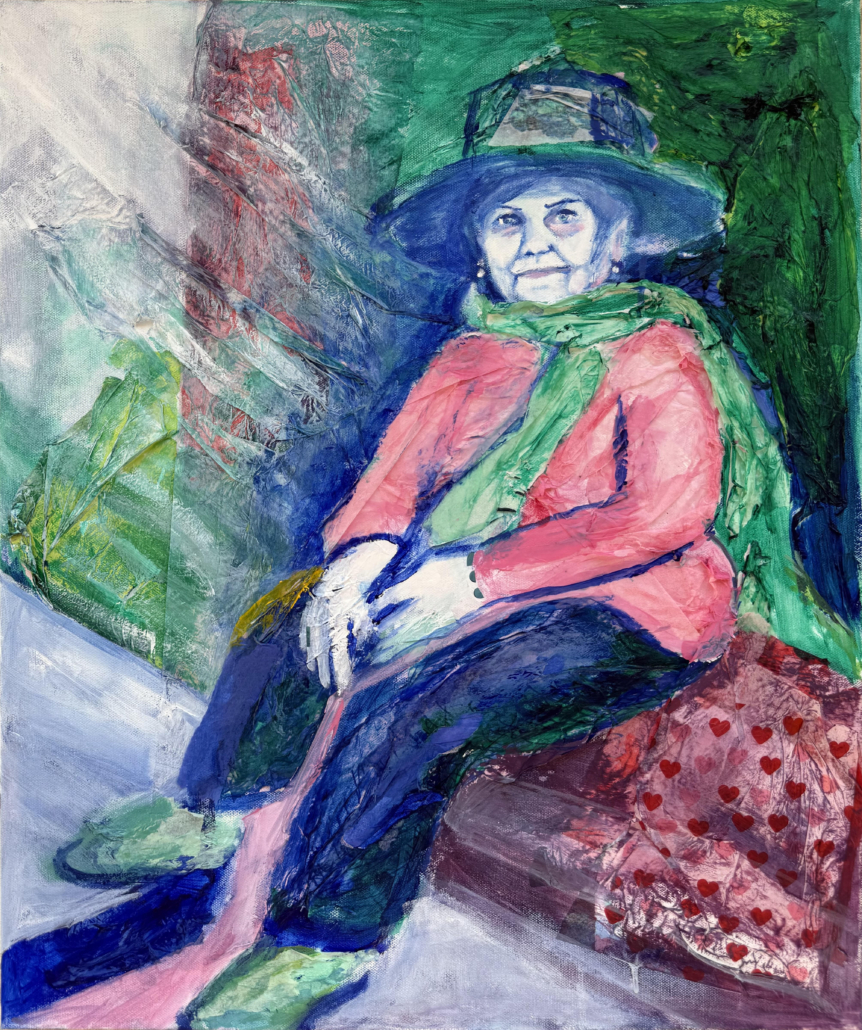
In Memory of Sue, 20×24, Donna Lynn Caskey
 debora Ewing writes, paints, and screams at the stars because the world is still screwed up. She improves what she can with music collaboration, peer-review at Consilience Poetry Journal, or designing books for Igneus Press. Follow @DebsValidation on X and Instagram. Read her self-distractions at FolkWorks.org and JerryJazzMusician.com.
debora Ewing writes, paints, and screams at the stars because the world is still screwed up. She improves what she can with music collaboration, peer-review at Consilience Poetry Journal, or designing books for Igneus Press. Follow @DebsValidation on X and Instagram. Read her self-distractions at FolkWorks.org and JerryJazzMusician.com.
Donna Lynn Caskey – Daughter of the Tidewater
The Banjo Gal on Creativity, Service, Through-lines and Finding Your Own

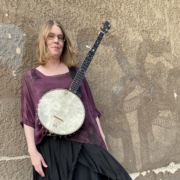 Donna Lynn Caskey
Donna Lynn Caskey
